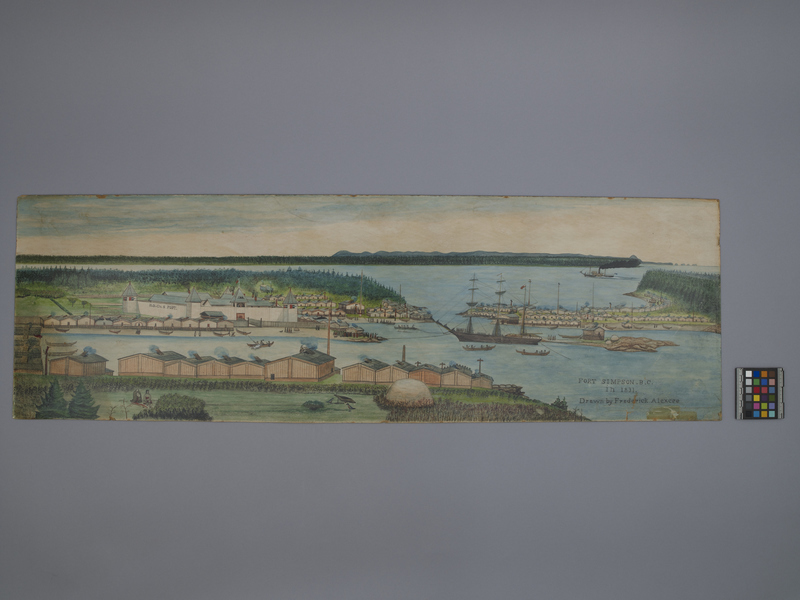Painting Item Number: 3281/1 from the MOA: University of British Columbia

Description
Watercolour painting depicting Fort Simpson and the village of Lax Kw'alaams. The image shows a coastal inlet with Tsimshian village houses built all around the shore, along with a large fort on the left, with "H.G.Co. S FORT" hand-printed on its wall. In the foreground there are two Tsimshian people sitting on the ground holding the end of a bird trap that runs to the right of the foreground, with two birds near the trap itself. Most of the houses have blue smoke coming out of the smoke-holes. There are canoes pulled up along the shore, as well as two in the water. A large rigged sailing vessel is anchored inside the inlet. Hand printed on the front lower right corner is "FORT SIMPSON .B.C. in 1831. Drawn by Frederick Alexcee". In the background, in the water, is a steamship with a plume of black smoke coming out its pipe. There is one settler-style house in the background on the left, behind the fort. A green mountain range runs across the horizon. The painting is on thin, somewhat flexible board.
History Of Use
In 1834, the Hudson’s Bay Company established a trading post, Fort Simpson (later Port Simpson), at the site of Lax Kw’alaams, a Ts’msyen settlement on the northern coast of British Columbia. The area had long been one of the main stopping places for Ts’msyen tribes of the lower Skeena River, who would travel to and from Old Metlakatla and the Nass River for oolichan fishing. Lax Kw’alaams became a large winter settlement as populations from the nine tribes dismantled their winter houses and rebuilt them at their former campsites around the fort. By the 1850s, Lax Kw’alaams had become a coastal centre for trade, with 140 Ts’msyen houses. This is the scene that Frederick Alexcee has painted here, although the date he wrote into the title – 1831 – must have been an error, since neither the fort nor the houses were there at that time.
Item History
- Made by Frederick Alexcee (Maker) in Port Simpson, British Columbia, Canada and Lax Kw'alaams, British Columbia, Canada during 1900
- Owned by Gary R. Bell before January 3, 2018
- Received from Gary R. Bell (Donor) on January 3, 2018
What
- Name
- Painting
- Identification Number
- 3281/1
- Type of Item
- painting
- Overall
- height 35.6 cm, width 112.6 cm
Who
- Culture
- Tsimshian
- Creator
- Frederick Alexcee (Maker)
- Previous Owner
- Gary R. Bell
- Received from
- Gary R. Bell (Donor)
Where
- Holding Institution
- MOA: University of British Columbia
- Made in
- Port Simpson, British Columbia, Canada and Lax Kw'alaams, British Columbia, Canada
When
- Creation Date
- during 1900
- Ownership Date
- before January 3, 2018
- Acquisition Date
- on January 3, 2018
Other
- Item Classes
- paintings
- Condition
- good
- Current Location
- Case 17
- Accession Number
- 3281/0001